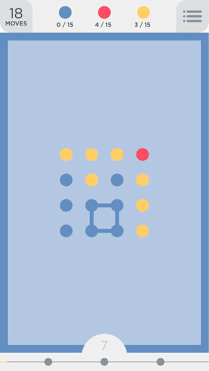Fox Ciel is playing a mobile puzzle game called "Two Dots". The basic levels are played on a board of size n × m cells, like this:

Each cell contains a dot that has some color. We will use different uppercase Latin characters to express different colors.
The key of this game is to find a cycle that contain dots of same color. Consider 4 blue dots on the picture forming a circle as an example. Formally, we call a sequence of dots d1, d2, ..., dk a cycle if and only if it meets the following condition:
- These k dots are different: if i ≠ j then di is different from dj.
- k is at least 4.
- All dots belong to the same color.
- For all 1 ≤ i ≤ k - 1: di and di + 1 are adjacent. Also, dk and d1 should also be adjacent. Cells x and y are called adjacent if they share an edge.
Determine if there exists a cycle on the field.
The first line contains two integers n and m (2 ≤ n, m ≤ 50): the number of rows and columns of the board.
Then n lines follow, each line contains a string consisting of m characters, expressing colors of dots in each line. Each character is an uppercase Latin letter.
Output "Yes" if there exists a cycle, and "No" otherwise.
3 4
AAAA
ABCA
AAAA
Yes
3 4
AAAA
ABCA
AADA
No
4 4
YYYR
BYBY
BBBY
BBBY
Yes
7 6
AAAAAB
ABBBAB
ABAAAB
ABABBB
ABAAAB
ABBBAB
AAAAAB
Yes
2 13
ABCDEFGHIJKLM
NOPQRSTUVWXYZ
No 代码:#include <cstdio> #include <cstring> #include <iostream> #include <algorithm> using namespace std; int t[4][2]={{1,0},{-1,0},{0,-1},{0,1}}; int vis[55][55]; int mark; int m,n; char s[55][55]; void dfs(int x1,int y1,int x2,int y2) { vis[x1][y1]=1; for(int i=0;i<4;i++) { int X=x1+t[i][0]; int Y=y1+t[i][1]; if(X>=0&&Y>=0&&X<n&&Y<m&&(X!=x2||Y!=y2)&&s[x1][y1]==s[X][Y]) { if(vis[X][Y]==1) { mark=1;break; } dfs(X,Y,x1,y1); } } } int main() { scanf("%d%d",&n,&m); memset(vis,0,sizeof(vis)); memset(s,0,sizeof(s)); for(int i = 0; i < n ; i++) { scanf("%s",s[i]); } mark = 0; for(int i = 0; i < n; i++) { for(int j = 0; j < m; j++) { if(!vis[i][j]) { dfs(i,j,-1,-1); if(mark) { printf("Yes\n"); return 0; } } } } printf("No\n"); return 0; }
























 1万+
1万+

 被折叠的 条评论
为什么被折叠?
被折叠的 条评论
为什么被折叠?








